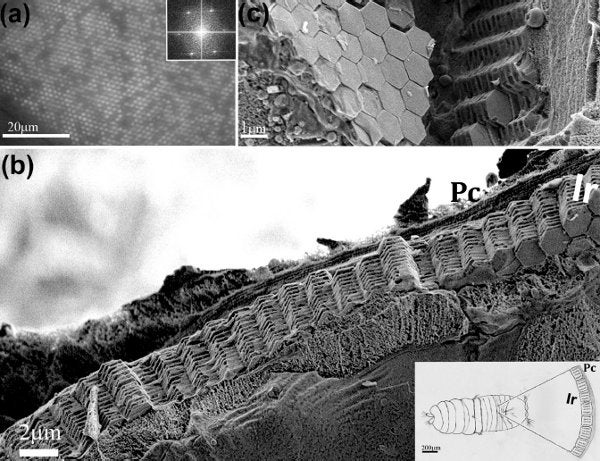This article was published in Scientific American’s former blog network and reflects the views of the author, not necessarily those of Scientific American
The sea sapphire combines the brilliance of a morpho butterfly, the cuteness of copepod, and the cloaking skills of a Klingon Bird-of-Prey. One second it shimmers brightly with color and then, poof, it disappears before your eyes. Have a look at this video from the Journal of the American Chemical Society to see what I mean.
Sea sapphires are copepods -- little crustaceans with long antennae that live nearly everywhere water is found. In the open ocean, they live between the surface and about 1,000 feet.
On supporting science journalism
If you're enjoying this article, consider supporting our award-winning journalism by subscribing. By purchasing a subscription you are helping to ensure the future of impactful stories about the discoveries and ideas shaping our world today.
The flashes of color they produce help them stand out from the endless blue and vary by the depth each species prefers. Yellow, orange, and red sea sapphires are found closer to the surface of the sea, while greens, blues, violets and magentas are found deeper where only light of these shorter wavelengths can penetrate. However, even within species individual sea sapphires can vary in the colors they produce. Scientists think their colorful displays help mating partners find each other.
Male sea sapphires swim in spirals when displaying to females, and in this way the intermittent flashes produced by their bodies may act like signals of the sort demonstrated by light-producing ostracods I wrote about last year . The sea sapphires' momentary disappearance during their spiral swim may also act to deter predators.
No less astounding than their light and magic displays are the guanine crystal reflectors that produce them, found in perfect hexagonal arrays under the chitinous cuticle of the copepod.
Here they are:

Views of the guanine light-reflecting crystals of sea sapphires. (a) shows the hexagonal array as seen under a light microscope. (b) shows a cross-section of this layer under the scanning electron microscope. Note the stacked layers of crystals separated by layers of cytoplasm. Pc= procuticle. Ir=iridophores. (c) shows the "tightly packed perfectly hexagonal crystal" arrays and another side view of the crystals separated by cytoplasm layers. Sea sapphires would clearly make the ultimate Settlers of Catan game space. Fig. 1 from Gur et al. 2015. Click here for source.
If guanine sounds familiar, there is a reason – it is the G (or at least part of the G) in the famous A,C,T, and G that make up DNA. There are 10-14 layers of guanine crystals and cytoplasm in the sea sapphire Sappharina metallina, and 5-8 layers in Copilia mirabilis.
Similar systems are found in chameleons, iridescent fish scales, and silver spiders. The fish scales, spiders, and sea sapphires crystals are also in thin plate form, but only those of the sea sapphires are perfect hexagons.
A team of Israeli scientists was curious about how they produce different colors using their crystal reflectors. Although they knew the crystals were involved somehow, the previous hypothesis conjecturing that variations in the thickness of the guanine crystals produces the different colors proved to be a dud. It turned out all copepod guanine reflectors are exactly the same thickness – 70 nanometers.
So the scientists decided to look at the spacing of the cytoplasm – the soup-like contents of a cell -- layers between the crystals. This proved to be the key, as they announced in a paper in the Journal of the American Chemical Society last month. The thickness of cytoplasm ranged from 50 to 200 nanometers, and this variation was the factor that determined sea sapphire color. Thicker layers of cytoplasm between the crystal layers lead to longer wavelengths of reflected light, although a secondary emission peak can be observed in the violet or deep blue light when the primary peak is in all the way over in the ultra-long wavelength near-infrared. The combination of colors results in a magenta tone in the copepod.
In addition, the angle at which the light strikes the copepod affects the color of light reflected – or whether it reflects any light at all. In sea sapphires that appear to disappear, as the angle of light shifts from directly over the sea sapphire's back to smaller and smaller incident angles, the wavelength of light emitted grows shorter and the color more violet until it shifts into the UV spectrum, making it effectively invisible to human eyes.
Reference
Gur, Dvir, Ben Leshem, Maria Pierantoni, Viviana Farstey, Dan Oron, Steve Weiner, and Lia Addadi. "The Structural Basis for the Brilliant Colors of the Sapphirinid Copepods."Journal of the American Chemical Society (2015).